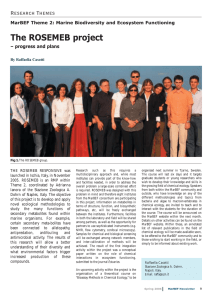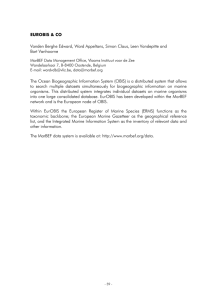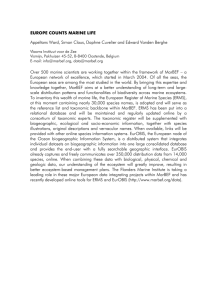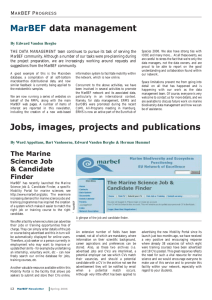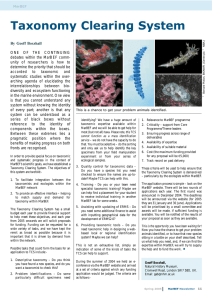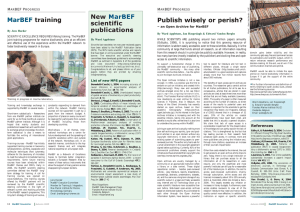New species MarBEF scientific publications
advertisement
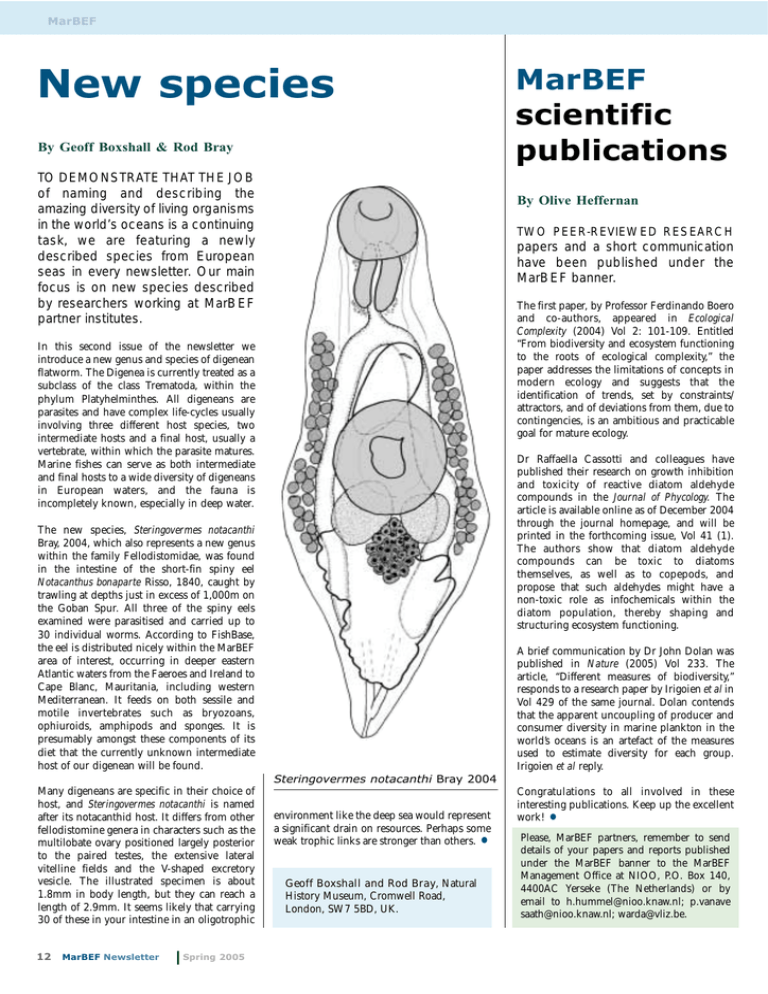
MarBEF MarBEF scientific publications New species By Geoff Boxshall & Rod Bray TO DEMONSTRATE THAT THE JOB of naming and describing the amazing diversity of living organisms in the world’s oceans is a continuing task, we are featuring a newly described species from European seas in every newsletter. Our main focus is on new species described by researchers working at MarBEF partner institutes. By Olive Heffernan TWO PEER-REVIEWED RESEARCH papers and a short communication have been published under the MarBEF banner. The first paper, by Professor Ferdinando Boero and co-authors, appeared in Ecological Complexity (2004) Vol 2: 101-109. Entitled “From biodiversity and ecosystem functioning to the roots of ecological complexity,” the paper addresses the limitations of concepts in modern ecology and suggests that the identification of trends, set by constraints/ attractors, and of deviations from them, due to contingencies, is an ambitious and practicable goal for mature ecology. In this second issue of the newsletter we introduce a new genus and species of digenean flatworm. The Digenea is currently treated as a subclass of the class Trematoda, within the phylum Platyhelminthes. All digeneans are parasites and have complex life-cycles usually involving three different host species, two intermediate hosts and a final host, usually a vertebrate, within which the parasite matures. Marine fishes can serve as both intermediate and final hosts to a wide diversity of digeneans in European waters, and the fauna is incompletely known, especially in deep water. Dr Raffaella Cassotti and colleagues have published their research on growth inhibition and toxicity of reactive diatom aldehyde compounds in the Journal of Phycology. The article is available online as of December 2004 through the journal homepage, and will be printed in the forthcoming issue, Vol 41 (1). The authors show that diatom aldehyde compounds can be toxic to diatoms themselves, as well as to copepods, and propose that such aldehydes might have a non-toxic role as infochemicals within the diatom population, thereby shaping and structuring ecosystem functioning. The new species, Steringovermes notacanthi Bray, 2004, which also represents a new genus within the family Fellodistomidae, was found in the intestine of the short-fin spiny eel Notacanthus bonaparte Risso, 1840, caught by trawling at depths just in excess of 1,000m on the Goban Spur. All three of the spiny eels examined were parasitised and carried up to 30 individual worms. According to FishBase, the eel is distributed nicely within the MarBEF area of interest, occurring in deeper eastern Atlantic waters from the Faeroes and Ireland to Cape Blanc, Mauritania, including western Mediterranean. It feeds on both sessile and motile invertebrates such as bryozoans, ophiuroids, amphipods and sponges. It is presumably amongst these components of its diet that the currently unknown intermediate host of our digenean will be found. A brief communication by Dr John Dolan was published in Nature (2005) Vol 233. The article, “Different measures of biodiversity,” responds to a research paper by Irigoien et al in Vol 429 of the same journal. Dolan contends that the apparent uncoupling of producer and consumer diversity in marine plankton in the world’s oceans is an artefact of the measures used to estimate diversity for each group. Irigoien et al reply. Steringovermes notacanthi Bray 2004 Many digeneans are specific in their choice of host, and Steringovermes notacanthi is named after its notacanthid host. It differs from other fellodistomine genera in characters such as the multilobate ovary positioned largely posterior to the paired testes, the extensive lateral vitelline fields and the V-shaped excretory vesicle. The illustrated specimen is about 1.8mm in body length, but they can reach a length of 2.9mm. It seems likely that carrying 30 of these in your intestine in an oligotrophic 12 MarBEF Newsletter Spring 2005 environment like the deep sea would represent a significant drain on resources. Perhaps some weak trophic links are stronger than others. • Geoff Boxshall and Rod Bray, Natural History Museum, Cromwell Road, London, SW7 5BD, UK. Congratulations to all involved in these interesting publications. Keep up the excellent work! • Please, MarBEF partners, remember to send details of your papers and reports published under the MarBEF banner to the MarBEF Management Office at NIOO, P.O. Box 140, 4400AC Yerseke (The Netherlands) or by email to h.hummel@nioo.knaw.nl; p.vanave saath@nioo.knaw.nl; warda@vliz.be.
